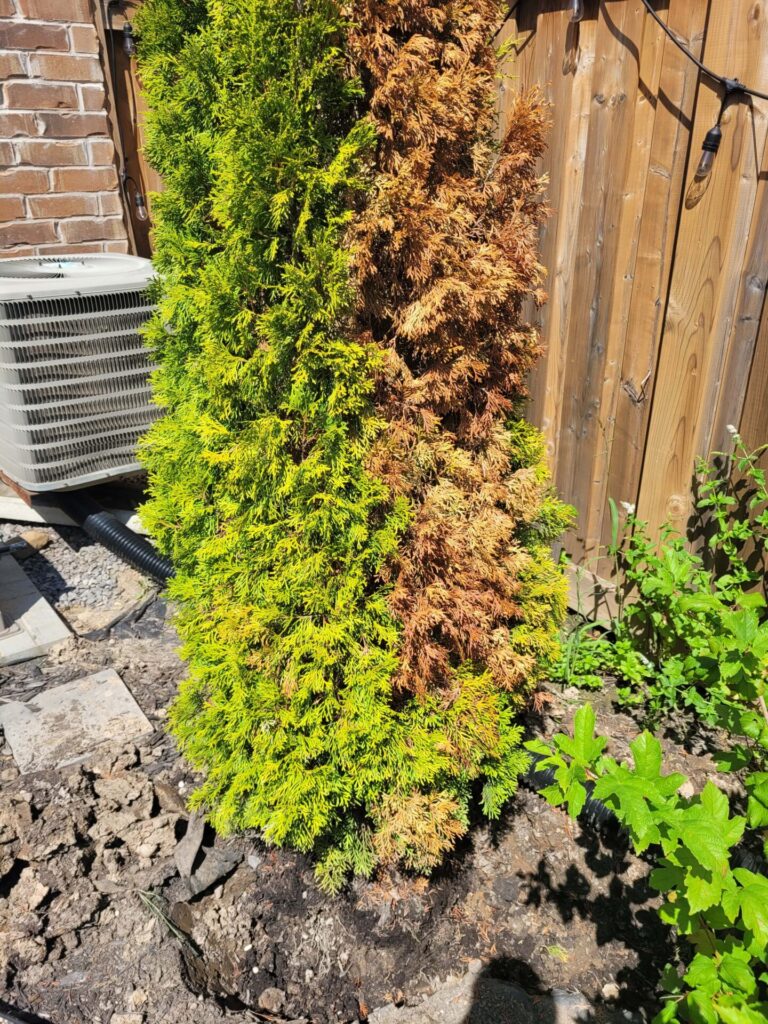
I planted this Cedar tree last year and it was fine during winter but it started to brown in the spring/sunner time. I notices that the soil was always moist and figured that water is not draining so I started to dig a trench with the idea of inserting some pipes in the soil to help drain. When I dug, I realized that there is not much soil for the tree in the first place and it’s just sitting on clay. I’m planning on digging out the tree, making the hole bigger and filling it with some river rocks and then soil. Any advice?
The tree is 7 ft tall and 2 to 2.5 ft wide.
Thank you for contacting the Toronto Master Gardeners.
Choosing the right plant for the right location is crucial for plants to not only survive but for them to thrive.
Soil quality is important and adding organic material really helps to give your new plantings a good start. However, it is generally recommended that you use the soil that was removed from the planting hole to backfill, adding triple mix or other organic material as top dressing. The reason for this practice is that when the roots encounter an amended high nutrient soil around the root ball, the tree is less likely to send out its roots past this looking for nutrients and water, leading to a smaller less stable root structure and in many cases, effectively the plant roots become girdled. If/when the roots do grow through this amended soil to reach the natural garden soil itself, their growth may be slowed and their nutrient intake reduced, This can result in stress to the plant, which in turn can cause browning. If your soil is clay, this stress to the roots, and to the plant itself, may be more pronounced.
Adding stones will not help your situation if the underlying soil is clay and also they will not provide any nutrient value to the soil for the tree. As above, adding organic material such as well rotted manure or quality compost to the soil surface after planting will not only help feed your tree but will also amend the soil structure as soil microorganisms will distribute it downward through the soil for you. In your situation, this organic material top dressing should be an annual practice.
Adding a layer of mulch over the organic matter under the tree will help retain soil moisture, deter weeds and shade the tree roots – keeping the mulch away from the tree trunk is important.
Knowing the natural soil in your location is clay, watering should be done to reflect its ability to hold moisture and slower drainage. On your current watering schedule, if the soil is really moist, I would suggest you may be overwatering the tree and that could be a reason for the browning and dieback. Watering deeply/thoroughly once a week should be fine although if you are moving it to another location, are digging around it (damaging & stressing roots) or we have a period of exceptionally hot dry weather, you may need to water a second time. It’s as easy to kill a plant with overwatering as it is with underwatering.
Also, take into consideration the amount of rainfall your garden gets – this year has been quite wet with many heavy downpours. Watering using drip irrigation/soaker hose is also a good idea as the moisture goes straight onto the soil so less is lost to evaporation. Watering should be done right up until freeze up in the late fall/early winter so that the soil can retain moisture to see the plant through the winter.
Fertilizing the tree with a 30-10-10 formulation in the growing season (April/May, June and July) is appropriate. It is very important to follow exactly the directions for applying fertilizers so that they are absorbed into the soil and are able to reach the plant’s roots. Don’t fertilize in late summer as the tree needs to prepare to go dormant for the winter. In late fall/early winter you can fertilize with slow release nitrogen and phosphorus, which will give it a boost come spring.
I hope this information is helpful.

